The automatic bottle opener market is estimated to be valued at USD 756.5 million in 2025 and is projected to reach USD 1433.4 million by 2035, registering a compound annual growth rate (CAGR) of 6.6% over the forecast period. A market share erosion or gain analysis reveals a gradual gain in market share as demand for convenient, automated home appliances continues to increase. Between 2025 and 2030, the market grows from USD 756.5 million to USD 1,041.3 million, contributing USD 284.8 million in growth, with a CAGR of 7.5%. This early-phase growth is driven by consumer demand for convenience, as automatic bottle openers become popular in household kitchens, bars, and restaurants.
The growing trend towards home automation and smart kitchen appliances plays a significant role in fueling adoption. During this period, the market gains a significant share due to increased consumer awareness and the availability of affordable, user-friendly solutions. From 2030 to 2035, the market continues its upward trajectory, expanding from USD 1,041.3 million to USD 1,433.4 million, adding USD 392.1 million in growth, with a slightly lower CAGR of 5.9%. The deceleration in growth rate indicates the market approaching maturity, as widespread adoption has already occurred. Despite this, the market continues to gain share, supported by innovations in product design, ease of use, and additional features such as smart integrations and eco-friendly materials. The analysis highlights strong growth throughout the period, with gradual stabilization in the latter years.
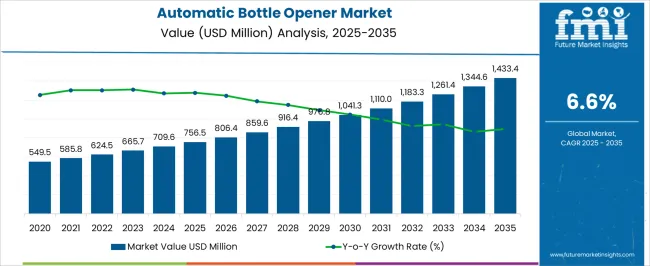
| Metric | Value |
|---|---|
| Automatic Bottle Opener Market Estimated Value in (2025 E) | USD 756.5 million |
| Automatic Bottle Opener Market Forecast Value in (2035 F) | USD 1433.4 million |
| Forecast CAGR (2025 to 2035) | 6.6% |
The current market landscape is shaped by the integration of compact electronics into traditionally manual tools, enabling faster, safer, and user-friendly bottle opening solutions. Growing consumer awareness around product ergonomics, ease of use, and time efficiency is playing a significant role in driving product adoption.
As observed in corporate product launches and investor presentations, consumer electronics trends have influenced the development of sleek, rechargeable, and cordless designs. The future growth of this market is anticipated to benefit from the increasing gifting culture, rising disposable income, and preference for modern home accessories. Additionally, innovations in packaging design and the growing presence of smart kitchenware are expected to provide further momentum.
The automatic bottle opener market is segmented by product type, bottle type, application, pricing, distribution channel, and geographic regions. By product type, the automatic bottle opener market is divided into Cordless automatic bottle openers and Corded automatic bottle openers. In terms of bottle type, the automatic bottle opener market is classified into Beer bottles, Wine bottles, Soda/Soft drink bottles, and Others.
Based on application, the automatic bottle opener market is segmented into Residential and Commercial. By pricing, the automatic bottle opener market is segmented into Medium, Low, and High. By distribution channel, the automatic bottle opener market is segmented into Online and Offline. Regionally, the automatic bottle opener industry is classified into North America, Latin America, Western Europe, Eastern Europe, Balkan & Baltic Countries, Russia & Belarus, Central Asia, East Asia, South Asia & Pacific, and the Middle East & Africa.
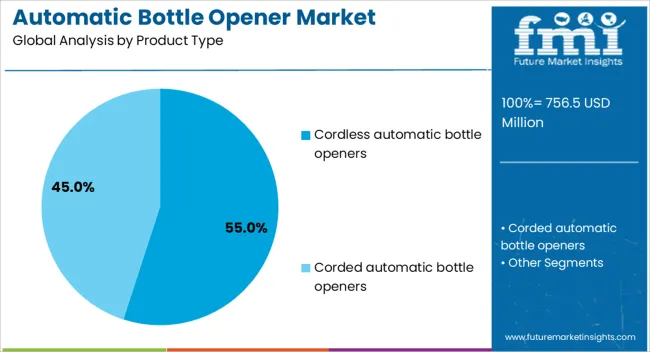
The cordless automatic bottle openers segment is projected to account for 55.0% of the Automatic Bottle Opener Market revenue share in 2025, establishing it as the leading product type. This dominance is being driven by rising consumer preference for portable and wireless kitchen tools that support effortless operation. Product announcements from home appliance brands have emphasized how cordless models offer greater flexibility and ease of use without the limitations of fixed power sources.
These openers are widely appreciated for their rechargeable battery capabilities, lightweight design, and compatibility with various bottle types, which make them ideal for both home and on-the-go usage. Retail and e-commerce trends indicate higher sales volumes for cordless variants due to their giftable appeal and compact storage benefits. Additionally, their ability to deliver a clean and consistent opening experience without manual effort has led to broader consumer acceptance.
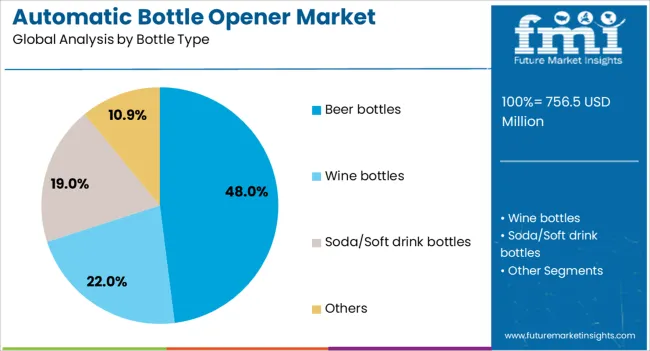
The beer bottles segment is anticipated to contribute 48.0% of the market revenue share in 2025, making it the dominant bottle type category. Growth in this segment is being supported by the widespread popularity of bottled beer across residential, commercial, and event-based settings. Industry publications and packaging innovations have highlighted the consistency in crown cap bottle usage for beer, which has driven the need for reliable automatic openers.
Consumer lifestyle trends indicate an increasing inclination toward casual drinking at home and in social gatherings, which has supported the use of openers compatible with beer bottles. Moreover, product manufacturers have designed openers specifically optimized for beer bottles, enhancing their usability and adoption.
The durability of beer bottles and their continued preference over cans for premium and craft brews have further contributed to this segment’s dominance. These factors have collectively reinforced beer bottles as the primary application area for automatic bottle opener usage.
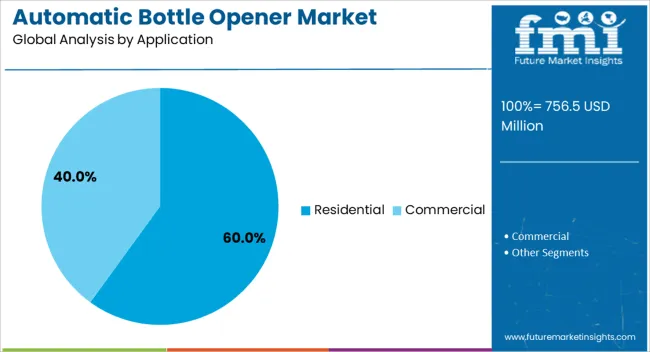
The residential segment is expected to account for 60.0% of the market revenue share in 2025, leading all end-use applications. This leadership position is being shaped by growing consumer demand for functional and aesthetic kitchen accessories designed for daily use. Increasing urbanization, smaller living spaces, and the rise of nuclear households have boosted the demand for easy-to-use tools that enhance user convenience.
Product portfolios from leading kitchenware brands show a clear emphasis on home-friendly designs with ergonomic features and sleek finishes. Online shopping behavior further supports this trend, with residential buyers seeking automated tools for both functionality and style. The appeal of automatic bottle openers as gifts and personal-use gadgets has expanded their use in home settings. Additionally, greater disposable income and the desire for lifestyle upgrades are contributing to the steady growth of this segment.
The automatic bottle opener market is growing due to the increasing demand for convenient, time-saving kitchen appliances. These devices offer ease of use, especially for individuals with limited hand strength or mobility issues, making them popular among older adults and people with disabilities. As the focus on enhancing consumer convenience and improving kitchen efficiency increases, automatic bottle openers are becoming a common household tool. Despite challenges such as high product costs and consumer resistance to adopting new technologies, innovations in design and the growing interest in smart kitchen gadgets continue to drive market growth.
The growth of the automatic bottle opener market is driven by the increasing consumer demand for convenient and easy-to-use kitchen solutions. Consumers are seeking products that save time and reduce effort in everyday tasks. Automatic bottle openers meet this demand by offering a hands-free solution to opening bottles, which is particularly beneficial for people with limited dexterity, arthritis, or other mobility issues. In addition, as consumers place more emphasis on enhancing their home appliances with smart and automated technology, automatic bottle openers are gaining traction. The growing focus on enhancing convenience, particularly in modern kitchens, further propels the market's expansion, with products offering easy, reliable, and quick bottle opening.
A primary concern is the high cost of production due to advanced features such as motorized components, smart technology integration, and premium materials. This drives up the price point, limiting accessibility to a niche market of affluent customers and businesses. Consumer skepticism about the long-term durability and reliability of electric or automated gadgets poses a barrier to adoption. Many consumers remain hesitant to invest in these devices, fearing that they might not stand the test of time. Furthermore, the competition from traditional manual bottle openers, which are inexpensive and widely available, adds pressure to the market. While automatic openers promise convenience, they must offer distinct value to justify their higher costs. Additionally, the market's reliance on a small, specific customer base means that greater consumer education and awareness are essential for widespread acceptance and growth.
The automatic bottle opener market presents significant opportunities through technological innovations and the growing aging population. With the rise of smart home technology, there is potential for integrating automatic bottle openers with voice-activated or app-controlled systems, allowing consumers to interact with their devices through connected platforms. The aging global population presents an opportunity for market growth, as older adults with limited hand strength increasingly seek easy-to-use kitchen appliances. Manufacturers can capitalize on this trend by designing more ergonomic, user-friendly, and accessible bottle openers. Expanding product offerings to cater to a wider demographic, including individuals with disabilities, can unlock new markets and increase adoption.
A key trend in the automatic bottle opener market is the integration of these devices with smart kitchen gadgets. Consumers are looking for kitchen appliances that can be controlled via smartphones or voice assistants, making it easier to perform everyday tasks.
The development of compact, sleek designs is also gaining popularity, with consumers preferring devices that are space-saving and blend seamlessly into modern kitchen aesthetics. Automatic bottle openers with multi-functional capabilities, such as being able to open bottles of various sizes or integrating with other automated kitchen systems, are becoming more common. These trends reflect the increasing demand for innovative, space-efficient, and connected kitchen tools.
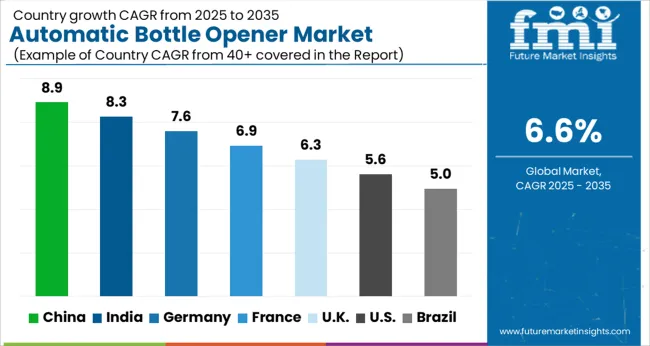
The automatic bottle opener market is projected to grow at a global CAGR of 6.6% from 2025 to 2035. China leads the market at 8.9%, followed by India at 8.3%, and Germany at 7.6%. The United Kingdom is expected to grow at 6.3%, while the United States records a growth rate of 5.6%. The increasing demand for automated, convenient household tools and innovations in smart kitchen devices are key factors driving the market. With growing disposable incomes and a shift toward smart home appliances, the demand for automatic bottle openers is rising globally. Emerging markets like China and India are driving this growth, while developed economies like the UK and USA continue to see steady adoption due to the high demand for convenience-driven kitchen products. The analysis includes over 40 countries, with the leading markets shown below.
The automatic bottle opener market in China is projected to grow at an 8.9% CAGR, supported by the country’s rapid urbanization and rising disposable income. With a growing middle class and increasing demand for household appliances, China is becoming one of the largest markets for automatic bottle openers. The shift towards smart home products and the growing trend of automation in everyday tasks are contributing to this growth. Consumers in urban areas are adopting more convenient, time-saving products, and automatic bottle openers fit well into this demand. The presence of domestic manufacturers offering cost-effective solutions is further boosting market growth.
Demad for automatic bottle opener in India is expected to grow at an 8.3% CAGR, fueled by the rising demand for convenience-driven kitchen tools. As India’s middle class continues to expand, more consumers are opting for smart and time-saving appliances. The increasing adoption of modern kitchen solutions and changing consumer preferences for automated devices is driving the market. In urban areas, where lifestyles are becoming busier, there is a growing need for products that simplify household tasks. The growing availability of affordable automatic bottle openers through online platforms is further promoting market growth in India.

Germany’s automatic bottle opener market is projected to grow at a 7.6% CAGR, supported by a strong consumer preference for innovative kitchen solutions. As one of the leading markets for household appliances in Europe, Germany is experiencing steady demand for automated and convenience-driven products. The country's focus on high-quality, durable, and efficient products drives the market for automatic bottle openers. With a growing trend toward smart homes, German consumers are increasingly adopting advanced kitchen tools that provide both functionality and ease of use. Manufacturers in Germany are focusing on integrating advanced technologies and design innovations to cater to evolving consumer needs.
The UK’s automatic bottle opener market is expected to grow at a 6.3% CAGR, driven by the rising popularity of convenience-focused kitchen gadgets. The demand for automatic bottle openers is growing, especially in busy urban areas, as consumers look for ways to simplify everyday tasks. The UK market also benefits from the increasing trend of smart home technology, where automation in kitchen devices is becoming more mainstream. With a focus on ease of use and time-saving functionality, automatic bottle openers are increasingly being adopted in households, particularly in the younger, tech-savvy demographic.
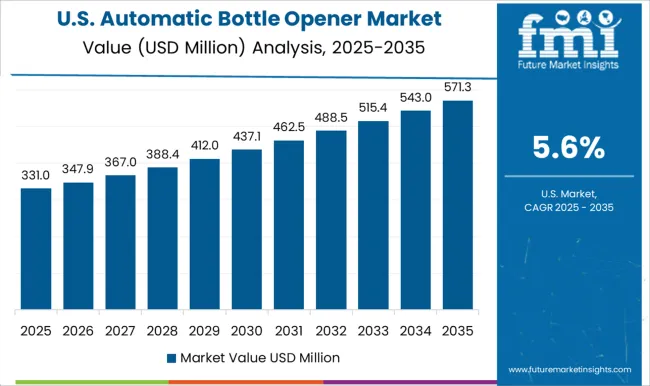
The USA automatic bottle opener market is projected to grow at a 5.6% CAGR, fueled by the demand for innovative and user-friendly kitchen products. As USA consumers become more interested in smart home solutions and automated devices, the adoption of automatic bottle openers is rising steadily. Convenience, time savings, and ease of use are key drivers of market growth, particularly in households with busy lifestyles. The USA market also benefits from the widespread availability of automatic bottle openers through retail and e-commerce platforms. The continuous innovation in design and functionality further enhances product appeal to a broad consumer base.
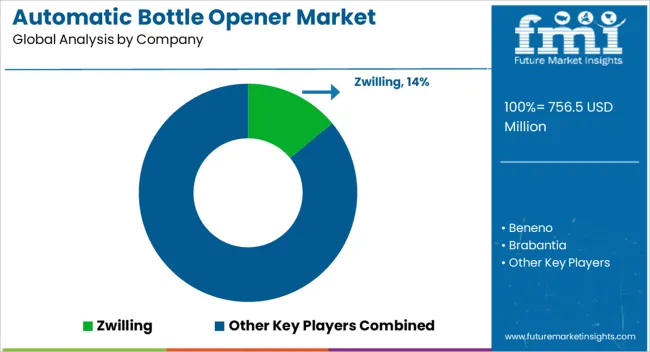
The automatic bottle opener market is driven by key players that specialize in creating innovative, user-friendly solutions for effortlessly opening bottles, particularly in the wine, beverage, and culinary industries. Zwilling is a prominent market leader, offering premium automatic bottle openers that focus on durability, performance, and sleek designs, catering to both professional kitchens and home consumers. Beneno provides high-quality automatic openers that emphasize ease of use and reliability, often featuring rechargeable, compact designs for home and restaurant use. Brabantia is known for producing elegant, functional automatic bottle openers designed for both style and efficiency, with a focus on customer convenience in home kitchens.
Chef Craft and Cuisinart are recognized for their automatic bottle openers that combine technology with ergonomic designs, offering solutions that cater to both casual home users and culinary professionals seeking quick and efficient bottle-opening methods. Ivation and Kikkerland stand out for their innovative and often multifunctional automatic bottle openers, offering solutions that enhance user experience through simplicity and modern technology. Oster provides automatic openers with an emphasis on value, performance, and ease of use, making them a popular choice in both retail and professional environments. Ozeri and Peugeot offer premium automatic bottle openers, often featuring rechargeable capabilities and sleek designs targeted at higher-end consumers. Pulltex, Rabbit, and Secura provide reliable, affordable automatic bottle openers, focusing on creating easy-to-use products for wine enthusiasts and home users. Tyzine and Wine Enthusiast offer solutions designed for wine lovers, combining functionality with innovative designs to meet the specific needs of the wine industry.
| Item | Value |
|---|---|
| Quantitative Units | USD 756.5 Million |
| Product Type | Cordless automatic bottle openers and Corded automatic bottle openers |
| Bottle Type | Beer bottles, Wine bottles, Soda/Soft drink bottles, and Others |
| Application | Residential and Commercial |
| Pricing | Medium, Low, and High |
| Distribution Channel | Online and Offline |
| Regions Covered | North America, Europe, Asia-Pacific, Latin America, Middle East & Africa |
| Country Covered | United States, Canada, Germany, France, United Kingdom, China, Japan, India, Brazil, South Africa |
| Key Companies Profiled | Zwilling, Beneno, Brabantia, Chef Craft, Cuisinart, Ivation, Kikkerland, Oster, Ozeri, Peugeot, Pulltex, Rabbit, Secura, Tyzine, and Wine Enthusiast |
| Additional Attributes | Dollar sales by product type (electric bottle openers, manual bottle openers, rechargeable bottle openers) and end-use segments (residential, commercial, hospitality, wine enthusiasts). Demand dynamics are driven by the growing popularity of wine and beverage consumption, increased focus on convenience in home and professional kitchens, and rising consumer interest in premium, high-performance tools. Regional trends show strong growth in North America and Europe, where wine culture is prevalent, while Asia-Pacific is expanding as wine consumption increases in emerging markets. |
The global automatic bottle opener market is estimated to be valued at USD 756.5 million in 2025.
The market size for the automatic bottle opener market is projected to reach USD 1,433.4 million by 2035.
The automatic bottle opener market is expected to grow at a 6.6% CAGR between 2025 and 2035.
The key product types in automatic bottle opener market are cordless automatic bottle openers and corded automatic bottle openers.
In terms of bottle type, beer bottles segment to command 48.0% share in the automatic bottle opener market in 2025.






Full Research Suite comprises of:
Market outlook & trends analysis
Interviews & case studies
Strategic recommendations
Vendor profiles & capabilities analysis
5-year forecasts
8 regions and 60+ country-level data splits
Market segment data splits
12 months of continuous data updates
DELIVERED AS:
PDF EXCEL ONLINE
Automatic Riveting Equipment Market Forecast and Outlook 2025 to 2035
Automatic Powder Forming Machine Market Forecast and Outlook 2025 to 2035
Automatic Weigh Price Labeling Machine Market Size and Share Forecast Outlook 2025 to 2035
Automatic Bending Machine Market Size and Share Forecast Outlook 2025 to 2035
Automatic Transmission Market Size and Share Forecast Outlook 2025 to 2035
Automatic Emergency Braking System Market Size and Share Forecast Outlook 2025 to 2035
Automatic Impact Testing Machine Market Size and Share Forecast Outlook 2025 to 2035
Automatic Glue Machine Market Size and Share Forecast Outlook 2025 to 2035
Automatic Floodgate Market Size and Share Forecast Outlook 2025 to 2035
Automatic Die Cutting Machines Market Size and Share Forecast Outlook 2025 to 2035
Automatic Dependent Surveillance-Broadcast (ADS-B) System Market Size and Share Forecast Outlook 2025 to 2035
Automatic Silver Sintering Die Attach Machine Market Size and Share Forecast Outlook 2025 to 2035
Automatic Emergency Braking (AEB) Market Size and Share Forecast Outlook 2025 to 2035
Automatic Identification and Data Capture Market Size and Share Forecast Outlook 2025 to 2035
Automatic Transfer Switch Market Size and Share Forecast Outlook 2025 to 2035
Automatic Weapons Market Size and Share Forecast Outlook 2025 to 2035
Automatic Hog Feeder Market Size and Share Forecast Outlook 2025 to 2035
Automatic Goat Waterer Market Size and Share Forecast Outlook 2025 to 2035
Automatic Wine Dispensers Market Size and Share Forecast Outlook 2025 to 2035
Automatic Content Recognition Market Size and Share Forecast Outlook 2025 to 2035

Thank you!
You will receive an email from our Business Development Manager. Please be sure to check your SPAM/JUNK folder too.
Chat With
MaRIA